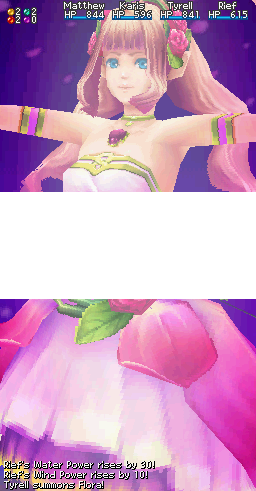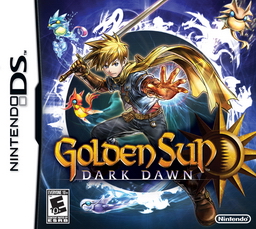When you first start a new game in Golden Sun: Dark Dawn, you get a long series of scrolling text explaining the major events that took place in the first two Golden Sun games, and the effects of the Golden Sun itself on the world of Weyard after the previous games. This is awfully long though, as it goes on for nearly 7 minutes. Half of the explanations could be done away with for those of us who have already played through the first two games, so you can tell that Camelot is targeting new audiences with this title. Even if that was the case though, the game tends to push the recaps of the first two games often, as there is an obstacle course you have to go through early in the game that is supposed to resemble the trials that the Warriors of Vale had gone through in the first two games, which is fairly simple and boring to play through. And if that's not enough, for those seeking more details in the events in the first two games, the game provides 5 items you can find in bookcases which gives you a summary of most of the events in the first two games as well in a neat animation. At least these are optional and skipable as well, unlike the slow and boring obstacle course.
 Graphics: The game is definitely pretty from the first look at the game. The environment and characters in the world look great with the 3D models, the textures used on the environments are more detailed and unique in comparison to Golden Sun: The Lost Age. Because of the game using 3D models now, the cut scenes and events during the game can utilize more dynamic camera angles. Another thing that you see right away is all the emoticons that the characters will frequently use during dialogue. They don't really add to the gameplay much, but they're there to give a little variety to dialogues and keep things moving even without words through the characters showing emotions frequently. It seems a bit unnecessary, but it's neat in its own way.
Graphics: The game is definitely pretty from the first look at the game. The environment and characters in the world look great with the 3D models, the textures used on the environments are more detailed and unique in comparison to Golden Sun: The Lost Age. Because of the game using 3D models now, the cut scenes and events during the game can utilize more dynamic camera angles. Another thing that you see right away is all the emoticons that the characters will frequently use during dialogue. They don't really add to the gameplay much, but they're there to give a little variety to dialogues and keep things moving even without words through the characters showing emotions frequently. It seems a bit unnecessary, but it's neat in its own way.However, I found that the game's pacing was rather slow as the game threw lots of dialogue at you, especially early on. Maybe it's to build more character early on to give a feel of their personalities, but the main character, Matthew, is just as same as Isaac and Felix was. Fairly mute, like most protagonists. The others tend to follow common archetypes as well, so character development isn't exactly all that impressive throughout the game.
| Matthew's means of communication. |
Another thing that may slow down your experiences with the game is the number of random encounters. They tend to be a bit common, but at least they removed or lowered the encounter rates in places where there are puzzles to keep the disruption to a minimum. In the later half of the game, I just used the Avoid Psynergy to reduce random encounters as much as possible to progress through the story as all the battles were fairly easy. Rarely did I have any trouble, let alone let anyone die until the last boss. Most random encounters can be dealt with by just spamming attack or casting multi-targetting psynergy if there are a lot of enemies. With how frequently you'll find artifact equipments, you'll rarely need to buy any generic equipments from stores, and it'll still keep you fairly strong throughout most of the game. I rarely even touched the Djinns for their effects in battle, and neither did I used any Summons either, which was fairly disappointing. The game is definitely easier than the previous two games, and the lack of a difficulty option, even if all it did was raise monsters' max HP, feels like it hurts the game as I definitely got bored of this game after a while, as it posed little challenge for me.
If battles aren't doing the game justice, what's left is the puzzles that made Golden Sun series so memorable. A couple of psynergies have been upgraded to have longer effect radii which is somewhat nicer. However, the puzzles the game provides also doesn't live up to the past two games' puzzles as they also tend to be easier. They don't offer the same complexity that the first two games had, especially later on, and on top of that, many psynergies were dropped that had many potential in this game. Sure, this game introduces new psynergies as well, but they seem so much more situational in comparison to those that were not brought back in Dark Dawn. Level designs don't seem any simpler, but the puzzles sure are, making me wonder whether if this was done intentionally to target the newer audiences again or not.
The Beauty of the Golden Sun series is the sense of being able to overcome obstacles and create your own paths with the use of Psynergy.Speaking of puzzles and battles, they are both needed to get a good deal of Djinn that are all around the world. They are important in collecting them for providing you with more power through changing your characters' classes, which affects their stats and psynergy pools. This is where the majority of the fun is at. By discovering new and stronger classes with certain combinations of the four elements, and balancing out your team with what you have allows for many strategic thoughts in what role each characters would play in combat, provides lots of interesting builds and strategies. However, this game contains 3 points in the game where you cannot backtrack to get any missed items or even Djinni. These Points of No Returns are story related and do not provide any alternatives for anything missed before them. Considering the long intro, slow pacing, the boring obstacle course, and the tediousness of it all, restarting the game for a missed Djinn is a hassle that's very discouraging.
 |
| Summon Flora |
Around halfway through the story did the game feel like it started to pace forward and get more interesting. Without spoiling anything, a major event occurs that's much greater than collecting a feather to repair the Soarwing, which has absolutely no importance at all in this game other than the initial quest. This major event provides much of what the game lacked; an incentive to keep playing through story progression, and a slight spike in difficulty in combat. Unfortunately, this is short lived as the end of the game creeps up on you fairly quickly. It's disappointing that the game only felt like it got good until the latter half, and when you finally get to it, it ends shortly after.
The ending once again hints at a sequel, much like the previous two games, and a sequel is most appropriate as this game left many things open and unanswered. I just hope that the next game doesn't take as long as this game did. GS: Dark Dawn came out in 2010, while the previous games were released in 2001 and 2003. Heck, it's already over a year since this game came out now, so hopefully the sequel will be out later this year, or next year since I haven't heard of any announcements about another title being in the works yet.
All in all, this game isn't terrible, but definitely disappointing for someone who has come to expect the qualities of the first two games. The outer qualities like graphics may be nicer, but the depth of the game feels toned down for the new audiences, and I feel like that's the wrong approach to really get new fans of the series anyway. Regardless, if you're a fan, it's worth picking it up and aim for a low level run of the game with the Avoid psynergy. I was able to defeat Dullahan, the hardest, optional boss in the game, at levels 47 to 49 range. Game clocked at 36:33.
If you're new to the series, feel free to play either this title first, or play them in order. However, keep in mind that this game will spoil majority of the events in the first two games. My personal recommendation is to play the games in order for +20 Fan Respect Points. If you do decide to play this one first, I would award you with +5 Fan Respect Points for each previous games you play, for a total of +10 FRP.





No comments:
Post a Comment